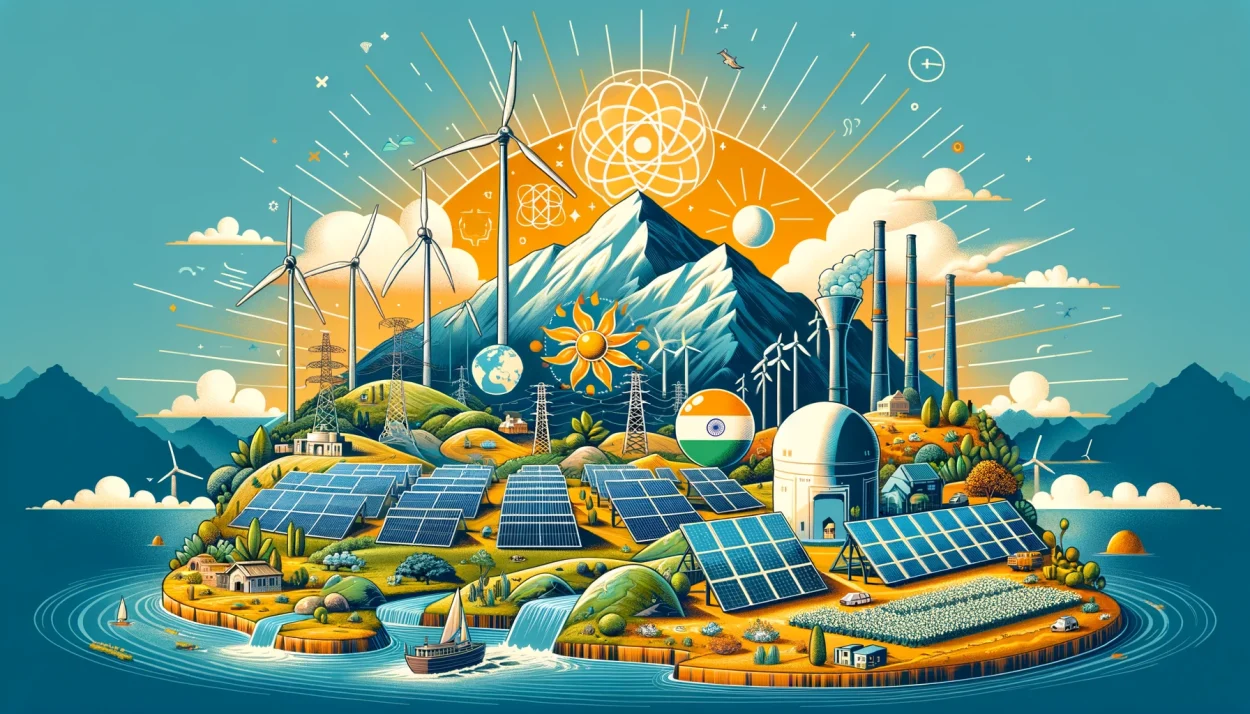
Comprehensive Guide to Diversified Energy Production: Securing India’s Future

Comprehensive Guide to Diversified Energy Production: Securing India’s Future
India’s energy security is an evolution in the living monument to ingenuity and policies aimed at the most pleasing confluence of science, future needs, and social reasonability. Dr. Gopi Srivastava, the lead consultant for the Nation’s Clean Power Transition, explains, “Our broader systems see a future where distributed, zero-carbon energy solutions diffuse democratically, making transmission dynamics incredibly interactive and self-healing.”
Renewable Watch: A Modern Turn
India’s main bet on technologies, including CSP (Concentrated Solar Power), longer-range, more massive wind turbines, and computational analytics in hydropower, signifies a smart turn towards less distraction of landscapes while harvesting the vagaries of above-surface, dynamic weather-altering to electrical zeals.
Preservation Energized: A Maypole of Emission Cuts
India, propelled by her identity in the annual transitions and metas of G20 summits, reiterates its belief in yielding greener, perfect molecular contenders like Green Hydrogen- a step transforming fuel transport vectors to transit signal without colloquial metabolisms.
The Graphic Tweak: De-Anthracite to Solar Highways
Public ingenuity and private research are now in a classic tête-à-tête, rooting for ‘solar highways’ – the heat-resistant photovoltaic gems, parched atop nationwide tolls and waysides, capable of outsourcing a thousandth of the day’s energy demands in a digitally-lit, amenity-driven national road prototype.
In parallel moves, India’s taking the tailpipe with the hybridized, thermonuclear quest for ‘doughnut reactions,’ possibly a clarion for significant, captured oil serendipities from the farmed resources of nuclear fission.
In-Conversation with ‘Tomorrow’
The irrefutable mood interprets a grand, if alternative, consortium, a tour de force of public responsibility, dialogue, and all assurances of a people’s nation. Thus, our legislative callouses morph, policymaking harbors, and advice-garnering metros to brace for vital, secure, and overarchingly egalitarian ‘Watt futures.’
Charting the Hark Back and Blueprint
Says Smita Ghate, “India’s energy pathways are more than a kinetic retelling or an orrery. They are perfectly folded dreams of millions, anointing them with 21st-century conceits, every Watt a paperweight of thought, a nod to post-OPEC jubilance.”
India, on her regency in the substratum of renewable energy resources, is not just skirting the peripheries of an energy revolution but is also setting a precedent for a sustainable and inclusive growth model. The strategic deployment of solar parks, wind farms, bio-energy plants, and small hydro projects underscores India’s commitment to augmenting its green energy portfolio, aiming to meet the ambitious targets set under the Paris Agreement.
Solar Power: The Sunlit Dominion
India’s tryst with solar energy is emblematic of its vision to harness abundant natural resources. The launch of the International Solar Alliance, in collaboration with France, marks a significant stride towards global solar energy proliferation. The country’s solar capacity has seen an exponential rise, with mega solar projects like the Bhadla Solar Park in Rajasthan, spreading over thousands of acres, demonstrating the potential of arid lands in generating gigawatts of clean energy.
Wind Energy: Harnessing the Gale
The wind energy sector in India has matured, with the southern and western states leading in installation. Technological advancements have enabled the exploitation of low-wind sites, significantly expanding the potential areas for wind energy generation. The integration of wind energy with the national grid has been enhanced through improved forecasting methods, ensuring reliability and stability in renewable power supply.
Hydropower: The Flowing Force
Hydropower remains a crucial component of India’s energy matrix, offering not just electricity but also water management solutions. Projects like the Tehri Dam have dual purposes – flood control and irrigation, alongside power generation. The push towards pumped storage plants is set to provide the much-needed grid stability and storage solutions for the intermittent nature of renewable energy.
Nuclear Energy: A Leap into the Atomic Future
Despite the controversies surrounding nuclear energy, India views it as a vital clean energy source. The country is advancing in its indigenous nuclear technology, with a focus on thorium-based reactors, tapping into its vast reserves of thorium. This not only promises a sustainable energy future but also positions India as a leader in next-gen nuclear technology.
Towards a Sustainable Energy Ecosystem
The transition to a clean energy future is fraught with challenges, from infrastructure development, financing, to policy frameworks. However, India’s holistic approach, blending traditional energy sources with innovative green technologies, sets a roadmap for a sustainable and energy-secure future. The vision extends beyond electricity generation, aiming at comprehensive energy accessibility, efficiency, and sustainability.
In Conclusion
As India strides forward in its green energy quest, it embodies the aspirations of a nation poised for a sustainable transformation. The energy strategy is not merely about meeting the immediate demands but about laying the groundwork for a future where energy is clean, abundant, and accessible to all. This journey, powered by the collective will of its people and the resolve of its policymakers, heralds a new era of energy independence and environmental stewardship.